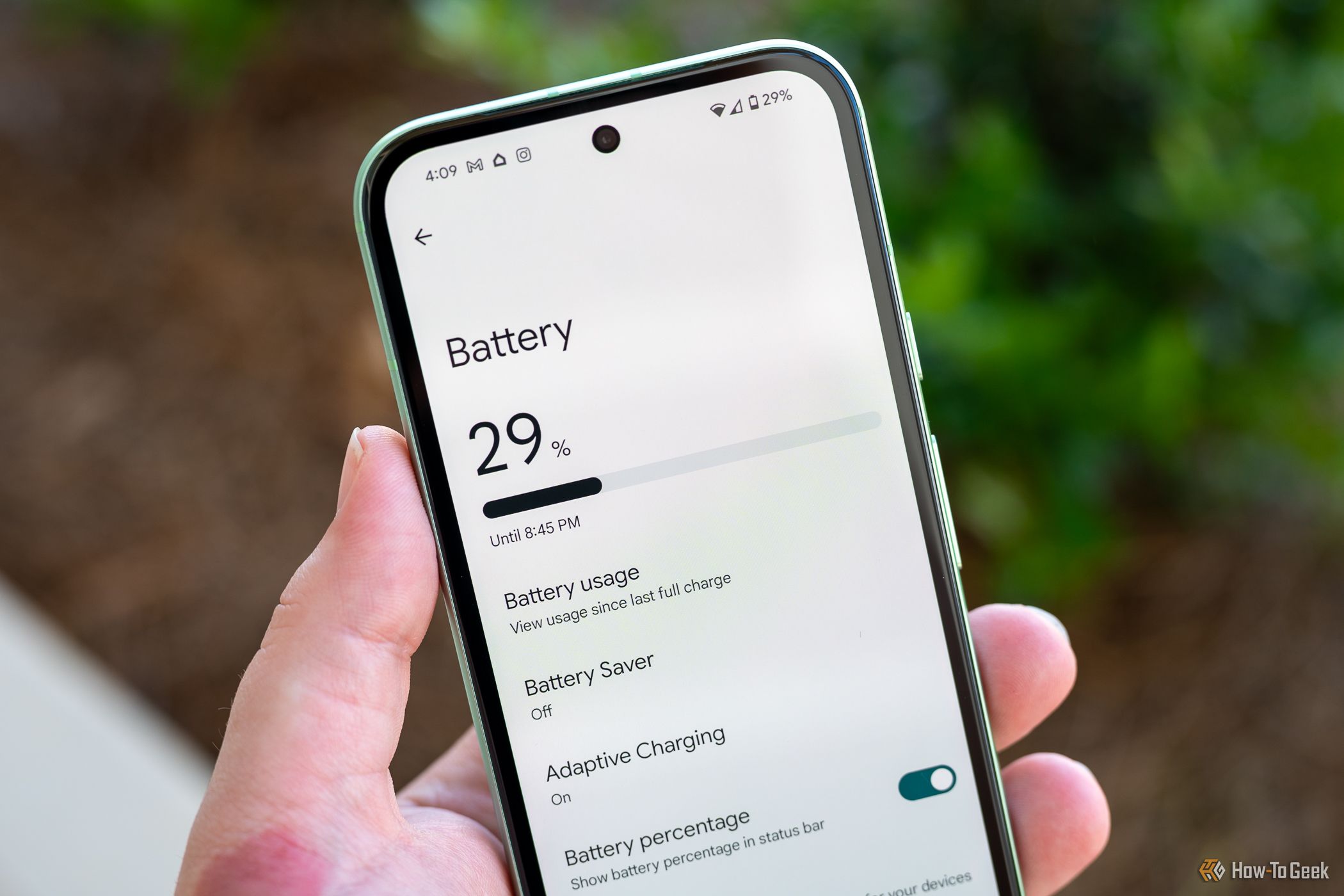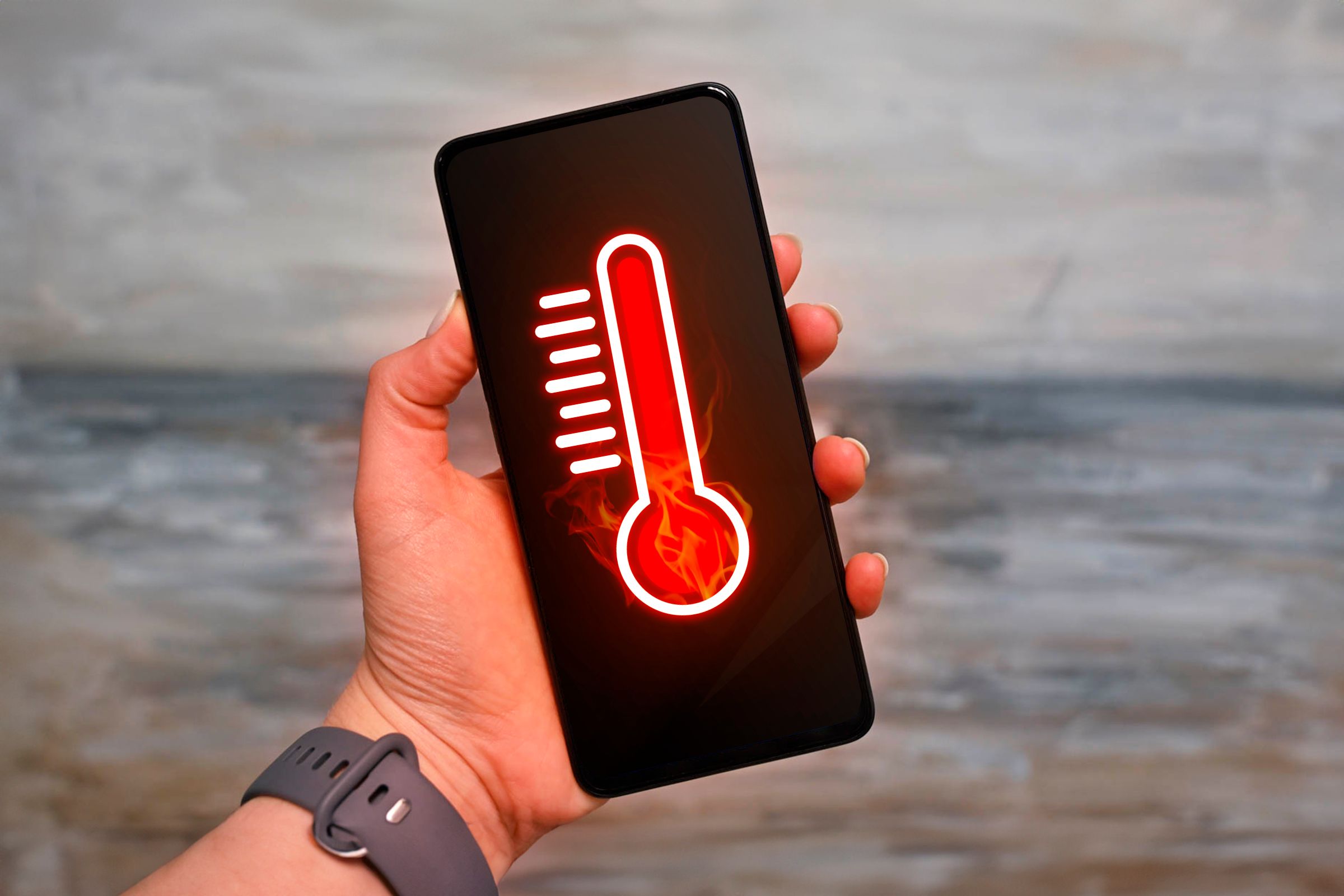You want your phone to last as long as possible, and the best way to do that is to care for the battery to minimize its degradation. Here are the best practices you should follow.
Don’t Leave Your Phone Empty or Full for Long
To understand how to preserve your phone’s battery health, it helps to know the basics of how a lithium-ion battery works. Every second you use your phone, tiny chemical reactions occur inside the battery to release stored energy. A lithium-ion battery has two terminals: a positive one (cathode) and a negative one (anode).
When your phone is in use (a.k.a. discharging), lithium ions move from the negative side to the positive side through a gel-like substance called the electrolyte, while electrons flow through the circuit outside in the same direction, powering your device.
When the battery is fully discharged, all the usable energy has been depleted, and your phone shuts off. Plugging in your phone reverses this process—electricity drives the lithium ions and electrons back to their original positions, recharging the battery.
Of course, the actual chemistry is more complex, but this covers the core idea. What matters is this: batteries don’t like staying fully charged or empty for long. These extreme states place more stress on the internal chemistry, which can speed up long-term degradation.
Set Your Phone to Limit Charging to 80%
In a perfect world, you’d keep your battery hovering around 50% all day, but that’s not realistic, so experts recommend keeping it between the 20-80% range whenever possible.
This doesn’t mean you should never fully charge your phone even when you know you’re going to need that extra 20%. The degradation escalates when you make it a habit to leave your phone empty or fully charged for extended periods of time.
Even overnight charging is safer these days, as modern phones can learn your charging habits to stop the charging at 80% while you’re sleeping and only resume it minutes before you wake up, so you start your day at 100%, but your phone doesn’t sit at 100% all night. It’s pretty clever. You should err on the side of caution if your phone doesn’t have this feature, though.
If you want to maximize your battery health, you can manually cap the charging at 80%. It’s a trade-off: you’ll need to charge your phone more often, which is a bit inconvenient, but you’ll have that peace of mind that you’re doing the right thing for your battery. Different companies label this feature differently in their UI, but you can easily find it in the battery menu.
Be Mindful of Your Charge Cycles
Let me bust a battery myth for you real quick: it doesn’t matter how many times a day you charge your phone. Topping up your battery in short bursts while doing chores, working, or commuting is perfectly fine. What really matters is the total number of charge cycles your phone goes through.
A charge cycle isn’t just “one plug-in.” It’s defined as using the equivalent of 100% of your battery’s capacity, whether that happens in one go or spread out over time. For example, say you charge your phone from 0% to 50%, use it for a bit, then later charge it from 40% to 90%. You’ve plugged it in twice, but you’ve only used 100% total, so that’s one full charge cycle.
If your phone’s battery is able to retain 80% of its original capacity after 800 charge cycles, that’s usually considered normal by most manufacturers. Apple says the batteries of iPhone 15 (and presumably later) models are “designed to retain 80 percent of their original capacity at 1000 complete charge cycles under ideal conditions.” Xiaomi makes much bolder claims and says its 14T Pro can retain 80% capacity after up to 1600 charge cycles.
So, don’t stress about short charging sessions. In fact, frequent partial charges are healthier than letting your battery drain to zero and charging it all the way back up. It puts less strain on the battery chemistry and helps extend its lifespan.
Avoid Exposure to Extreme Temperatures
One of the easiest ways to protect your battery is to keep it out of extreme temperatures. You probably already know that heat is bad for batteries as it messes with their internal chemistry; that’s very true, but being too cold isn’t good for them either. Some people assume that because heat is harmful, cold must be better. That’s not true.
Even if your phone overheats, you should never chuck it inside the refrigerator. The rapid change in temperature can permanently damage the internals far more than overheating ever could, and the humid environment inside the refrigerator can lead to condensation, which can result in water damage, which is usually not covered under warranty.
The correct, foolproof way to cool down your phone is just to stop using it, close all apps, or temporarily power it off. According to Apple, the ideal temperature range for smartphones is between 62° to 72° F (16° to 22° C), and beyond 95° F (35° C), there’s a risk of permanent damage. If you’re traveling someplace where you know the temperatures are harsh, get an insulated phone pouch like this PHOOZY phone case.
Don’t Use Your Phone While It’s Charging
Fast charging isn’t as harmful as you might think, especially if you use it mindfully, but it’s not completely risk-free either. The faster your phone charges, the more current flows through it, and that generates a not-insignificant amount of heat. But there’s a nuance here: this heat does not start manifesting as soon as you plug in your phone.
Why? Because heat is essentially unabsorbed energy and lithium-ion batteries accept charge more easily when they’re running low. As the battery fills up—especially past 70–80%—internal resistance increases, and it becomes harder to force more energy in, and that’s when heat starts to spike.
Think of your battery like a dry sponge. At first, it soaks up water quite easily. But the wetter it gets, the harder it becomes to absorb more, until eventually, you’re just spilling water everywhere and making a mess. With batteries, that “mess” is heat.
Now, if you start using your phone while it’s charging, you’re adding to the problem. Your phone pulls energy from the battery to power its components, while the charger is trying to push energy into it. This tug of war generates more heat and leads to slower charging, higher wear, and long-term battery stress.
So, if you want to extend your battery’s lifespan, try to avoid using your phone while it’s charging, especially when it’s already past that 70% mark.
Avoid Wireless Charging
I get it—wireless charging is insanely convenient, and for some people, it’s a non-negotiable feature. But if you’re serious about preserving your battery’s health long-term, you’re better off sticking to a standard wired charger.
We’ve covered why wireless charging sucks before, but in a nutshell, it’s inefficient and generates more heat even if the wattage is relatively low compared to wired chargers.
Remember, heat is just unabsorbed energy, and since wireless charging works through electromagnetic induction (as opposed to wired charging’s direct electrical conduction), there’s more energy loss, especially if the copper coils are misaligned.
If you only use wireless charging on rare occasions, it’s not a huge deal, but I would still recommend using wired charging whenever you can to preserve battery health.
Avoid Heavy Games Your Phone Can’t Handle
If you’re using a budget or older phone, chances are it wasn’t built with high-end gaming in mind. Sure, there are exceptions—some Chinese brands offer solid specs at surprisingly low prices—but even then, it’s best to play within your device’s limits. Don’t push max settings unless your phone can handle it.
I don’t usually rely on synthetic benchmarks, since they can be (and have been) manipulated and often don’t reflect real-world use. But if you’re going to check them anyway, an AnTuTu score of 700,000 or more is a decent baseline for running most modern games on medium settings without serious heating, at least for short sessions.
Of course, that’s a rough estimate. Performance isn’t just about the chip; thermal management and software optimization matter just as much. If you’re planning to upgrade, test the phone yourself to see if it gets uncomfortably warm fast after intense gaming. If it does, it’s wiser to stick to lighter games.
Don’t Skip Software Updates
If you’ve had a bad experience with Android updates in the past, it’s understandable why you might want to avoid them. But doing so means your phone might not get the bug fixes and optimizations that can prolong battery life.
Android 14, for instance, closed a loophole that allows apps to run in the background indefinitely, resulting in reduced background activity by 50%, said Dave Burke, former Google VP of Engineering, in an interview. The less battery consumed, the less often you need to recharge, and hence, the slower you will exhaust your limited charge cycles.
Android 15 finally brought the charging limit feature to Pixel phones, and Android 16 adds a battery health menu so you can keep track of its degradation, just like the iPhone.
Get an Official Battery Replacement
A degraded battery is often the reason people upgrade their phones, but assuming there are spare parts available for your handset, a quick battery replacement by the manufacturer can give it new life so you can keep your phone for several more years.
Apple and Samsung are naturally the best options in this regard, as they usually have spare parts available for phones several years old.
With the introduction of new silicon-carbon batteries, it’s likely that our battery problems will cease to exist in the next few years, as we’re already seeing phones with up to 8000mAh hit the shelves. For now, do everything you can to prolong your battery’s health so you can upgrade when the time is right.










Leave a Comment
Your email address will not be published. Required fields are marked *